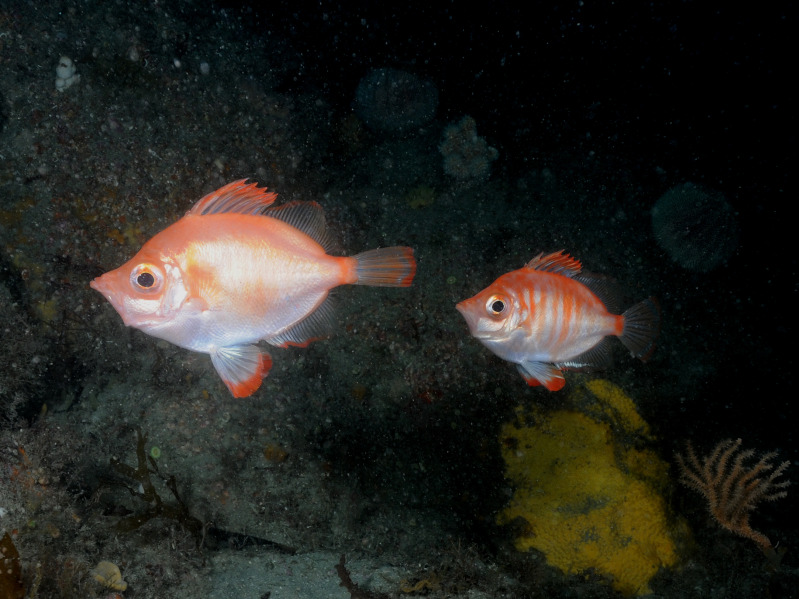Boar fish (Capros aper)
Distribution data supplied by the Ocean Biodiversity Information System (OBIS). To interrogate UK data visit the NBN Atlas.Map Help
| Researched by | Natalie Sweet | Refereed by | Admin |
| Authority | (Linnaeus, 1758) | ||
| Other common names | - | Synonyms | - |
Summary
Description
An oval, deep bodied fish with large eyes. Maximum recorded size 30 cm, with males being smaller than females. The snout is concave and long, with a protrusible mouth forming a short tube. Dorsal spines are strong and long. Anal spines are short and thin. The pelvic fin has a strong spine with five stout soft rays but these do not extend very far beyond the 2nd anal spine. The boar fish has small scales which are rough to touch. Individuals of Capros aper from deep water of 200 m or more are a brick red colour, sometimes with yellow bars. Shallow water specimens are often yellow or straw coloured.
Recorded distribution in Britain and Ireland
Found off the southwest coast of Britain and Ireland.Global distribution
East Atlantic, West Norway, West Scotland to Senegal. Also found in the Mediterranean Sea.Habitat
A demersal marine fish with a depth range of 40 to 700 m. Found mainly over rock or coral but also on sandy ground.Depth range
-Identifying features
- Long concave snout
- Protusible mouth forming a short tube
- Pelvic fin has strong spine and five stout soft rays but these do not extend much beyond the 2nd anal spine
- Deep water fish from 200 m plus are a brick red colour, sometimes with yellow bars
- Shallow water fish often yellow or straw coloured
Additional information
The boar fish feeds on crustaceans, mainly copepods, shrimps, worms and molluscs.
Spawning in northern waters occurs between June and August.
Listed by
- none -
Bibliography
FishBase, 2000. FishBase. A global information system on fishes. [On-line] http://www.fishbase.org, 2001-05-03
Howson, C.M. & Picton, B.E., 1997. The species directory of the marine fauna and flora of the British Isles and surrounding seas. Belfast: Ulster Museum. [Ulster Museum publication, no. 276.]
Wheeler, A., 1969. The fishes of the British Isles and north-west Europe. London: Macmillan.
WoRMS 2007. The World Register of Marine Species (WoRMS). http://www.marinespecies.org, 2008-10-31
Datasets
Fenwick, 2018. Aphotomarine. Occurrence dataset http://www.aphotomarine.com/index.html Accessed via NBNAtlas.org on 2018-10-01
Isle of Wight Local Records Centre, 2017. IOW Natural History & Archaeological Society Marine Records. Occurrence dataset: https://doi.org/10.15468/7axhcw accessed via GBIF.org on 2018-09-27.
NBN (National Biodiversity Network) Atlas. Available from: https://www.nbnatlas.org.
OBIS (Ocean Biodiversity Information System), 2025. Global map of species distribution using gridded data. Available from: Ocean Biogeographic Information System. www.iobis.org. Accessed: 2025-07-24
South East Wales Biodiversity Records Centre, 2018. SEWBReC Fish (South East Wales). Occurrence dataset: https://doi.org/10.15468/htsfiy accessed via GBIF.org on 2018-10-02.
Citation
This review can be cited as:
Last Updated: 22/07/2008



